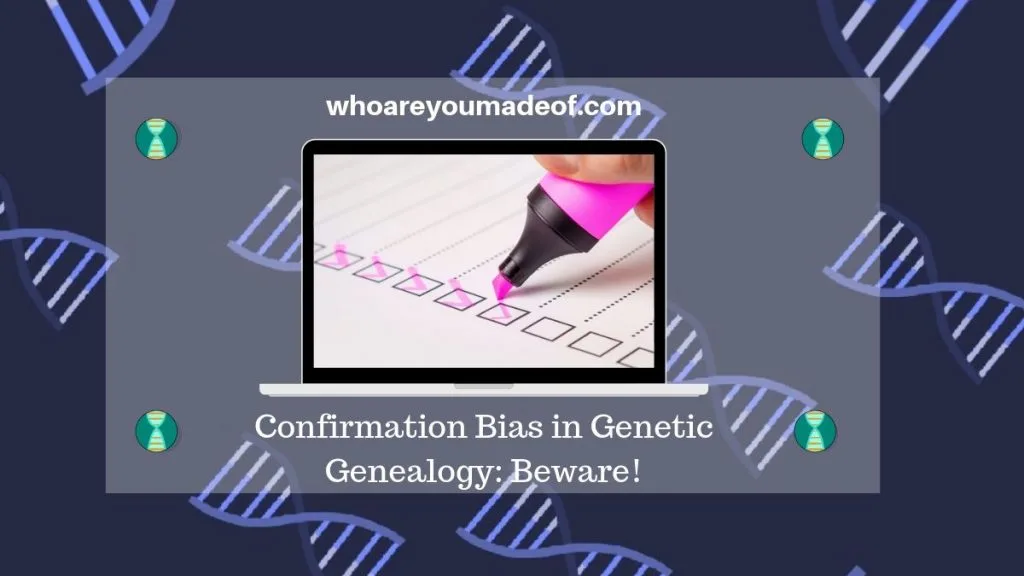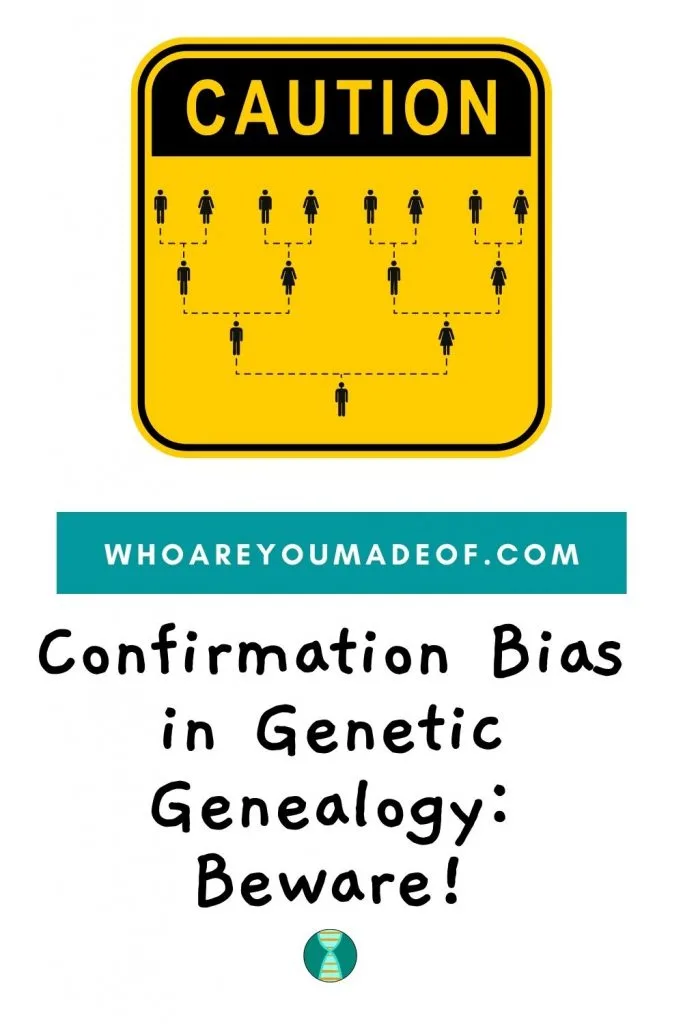If several people have the same wrong person in their family tree, and are DNA-matched, it could lead to incorrect conclusions. This is called "confirmation bias" in genetic genealogy and in this post, learn how to spot this scenario and avoid it.
You have a DNA match who has the same ancestor in their tree, so that proves that your family tree is correct, right? This means that both of you are really descended from that person who you both put in your tree, no?

What if both of you added the wrong person to your tree?
What got me interested in writing about this topic is my own experience researching my family tree. I'm pretty positive that one of the names in my family tree is incorrect, probably the result of a NPE (non-paternity event), but I'm having a lot of trouble pinpointing the particular person who shouldn't be there.
The problem is that I have so many DNA matches whose trees match my tree very nicely, giving me the impression that my family tree is 100% correct. Mystery solved, right?
Not so fast.
How to know that something is wrong in your family tree
What makes me so sure that there is someone in my tree who doesn't belong there? A few clues give it away.
The first bit of evidence is my ethnicity results. Even though it's true that ethnicity results cannot prove, or disprove, paternity, we can use it to decide whether it lines up with what we know about our family tree.
It can point us in the direction of something new about our ancestry that we haven't yet discovered.
I got a high percentage of Scandinavia in my Ancestry DNA results. I verified this with a 23 and Me test, and the results not only detected Scandinavian, they suggest that I have an ancestor from Denmark from within the past 200 years.
It should go without saying that I have no known Danish ancestors, and all lines of my family tree are complete going back 200 years - no Danish folks to speak of. In fact, as far as anyone in my family knows, we have no ancestors in any Scandinavian country.
The second clue that I have is that two of my older family members have a couple mystery DNA matches, one of them fairly close, who don't line up with my known family history. This is, to me, more proof that there is some sort of mystery that needs solving.
What does confirmation bias look like in a family tree?
It is obvious to me that the problem in my family tree is confirmation bias. I suspect that my great-great-great grandfather (let's call him Bob) might not really be my great-great-great grandfather. I don't mean to disparage the memory of my great-great-great grandmother (let's call her Sally), may she rest in peace, but what if a situation occurred where she got pregnant by another man while she was married to Bob?
Statistics show that this occurs in as many as 2-10% of births, so it's not a far-fetched idea, and I have actually seen this in action in my own closely related extended family.
If everyone else who is descended from Bob and Sally, or maybe just Sally (and not Bob), includes both Sally and Bob in their family tree, then it makes everyone else who is descended from that same couple feel sure that those are the correct two people to put in the tree.
And then we can all just carry on happily with our research, adding ancestors of both Bob and Sally to our trees.
Can verifying a connection a generation further back counteract confirmation bias?
One thing that might occur to you that could solve this problem might be to find people who are descended from Bob's parents. If I have a DNA match that descends from Bob's parents (through one of Bob's siblings), would it prove more definitively that I am, indeed, descended from Bob?
The problem with using this strategy is that the more distant the DNA match, the more likely it is that we could be related in a different way. If we use a descendant of Bob's parents as an example, this person could be my 5th cousin.
Fifth cousins are unlikely to share DNA, and if they do, they'll likely share only a small amount - maybe only one small segment?
If I share a small DNA segment with someone who appears to be descended from Bob's parents, how can I be sure that our matching segment is actually from Bob's parents and not from some other distant ancestor that we might share on another line of the family?
What if this supposed 5th cousin added Bob's parents to their family tree incorrectly? Bob's parents have one of the most common names in the United States, so it is conceivable that my DNA match might be researching the wrong family and added the wrong 4th great-grandparents to his tree.
This could lead to believe that I am wrong about Bob not being my ancestor, especially if I weren't paying attention. More confirmation bias! Oh my!
Confirmation bias is everywhere in genealogy
Confirmation bias can be detected in something as simply as comparing your family tree to a DNA match, or in something more technologically advanced like Common Ancestor Hints and ThruLines, both very useful Ancestry DNA tools that make family tree research easier.
I enjoy and use these tools, but I am also aware that some of the information that I might find could be tainted with the stain of confirmation bias.
Finally, it should be mentioned that with the advent of online family trees and even DNA testing, confirmation bias leading us astray in our research can become even more of a problem. The further back we go in our trees, the more possible descendants there are to include those ancestors.
For example, there might be as many as 35 million people descended from people who arrived to North America on the Mayflower - all descended from 51 people! Even if only a small percentage of those people are building family trees online, those are a lot of potential trees to provide some form of confirmation bias.
Since there are so many Mayflower descendants, it is likely that any two of those people are related to each other in more than one way. If those two Mayflower descendants happen to share a small segment of DNA, it can be mistakenly viewed as concrete proof that the family tree going back to the common ancestor (i.e. the Mayflower passenger) is correct.
If the Mayflower arrived in 1620 filled with adults of child-bearing age, these ancestors would be approximately the 14th great-grandparents of people my age alive today (assuming 25 years per generation). This is 16 generations back, at which point we have about 65,000 individual ancestors occupying the places of our 14th great-grandparents, assuming no pedigree collapse.
Many people who can trace their ancestry back to someone who immigrated to North America on the Mayflower likely share extensive ancestry with every other person whose ancestor arrived on the Mayflower. The result of this is that a shared DNA connection with another person descended from say, John Alden, doesn't mean that the DNA shared was inherited from John Alden, thus proving the connection.
I like using the Mayflower example, since it's so straightforward to understand. However, the same idea is true for everyone descended from anyone, which is all of us.
How to solve the confirmation bias problem in family trees?
So, is there a solution to this confirmation bias problem? Yes, there are a few ways that you can verify your relationship to your DNA matches without only depending on comparing your results with theirs and their family tree.
For example:
DNA testing for other people in your family, especially older relatives. By comparing the amount of DNA that you share and the amount of DNA that other, more closely related (to the common ancestor) people share with the DNA match, you can gather more data points for estimating your relationship, and more information that could be used for chromosome mapping (see next suggestion)
Chromosome mapping, in the form of DNA painting, can help you determine which DNA segments that you inherited from which ancestor, and could help you verify that a shared DNA segment with a match is from that ancestor and not a different ancestor

Conclusion
I hope that this post helped you understand a bit more about confirmation bias, and how to spot it if it is happening in your tree. Coming soon is a post about how to use chromosome mapping (via DNA Painter) to help verify connections in family trees and combat confirmation bias.
If you have any questions about something that you read here, or would like to add your own experience with confirmation bias in family tree research, I would love to hear from you in the discussion below.
Thanks for stopping by!

